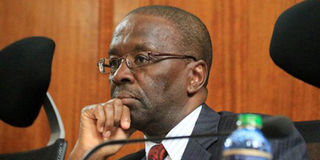Choosing Mutunga’s successor may take up to five months

Chief Justice Willy Mutunga follows proceedings at the Supreme Court on June 2, 2016 in the case in which Deputy Chief Justice Kalpana Rawal and suspended Judge Philip Tunoi are challenging the retirement age for judges. PHOTO | JEFF ANGOTE | NATION MEDIA GROUP
What you need to know:
- Conservative estimates indicate that choosing Chief Justice's successor is a process that at its smoothest would take between three and five months.
Willy Mutunga took early retirement as Chief Justice of Kenya this week. The office of Chief Justice is therefore vacant at the moment. It needs to be said that even though the senior most judge of the Supreme Court is by law the presiding Judge of the Supreme Court, the office of Chief Justice is itself vacant. This is because the Constitution of Kenya 2010 does not perceive of the office of an acting Chief justice. What may be held by the Deputy Chief Justice or a Supreme Court justice in the absence of the Chief Justice and the deputy Chief Justice is the presidency of the Supreme Court.
This explains the concern in some quarters as to the constitutional risks of simultaneous vacancies in the offices of the Chief Justice, the Deputy Chief Justice and a Supreme Court Justice.
In the old Constitution, the appointment of a judge or Chief Justice was the prerogative of the president. It was therefore possible for one to be an advocate in the morning and be sworn in as Chief justice in the early afternoon.
Today, the appointment of the Chief Justice and Deputy Chief Justice is now a shared responsibility between the three arms of government.
The Judicial Service Commission, which has now invited applications from interested persons through advertisements in the newspapers and the declaration of vacancies in the Kenya Gazette, has the primary responsibility. Thereafter, the Commission shall shortlist those who meet the required professional thresholds of 15 years as an advocate or judicial officer, or the same period as a legal academic or legal practitioner of note. In addition, there is the requirements of high moral probity coupled with established integrity by the applicants.
The Commission will then make an advertisement with a list of all the applicants and specifying the shortlisted candidates who will then be invited to attend interviews at a specified date.
The candidates will then be interviewed on the dates specified often in public which will then be followed by deliberations by the Commission to determine the person best qualified among the interviewed candidates.
A nomination of this single candidate will then be made to the President and the National Assembly. The National Assembly is required to conduct a public vetting for the candidate and determine their suitability or otherwise to occupy that office. The nominee is then required to appear before the Committee of Legal and Constitutional Affairs for scrutiny in determining fitness of the office beyond the professional requirements of the office of Chief Justice. The Committee is required to invite the public to make representations regarding the Nominee. These may be in support or disapproval. However, a person who wishes to oppose the Nominee would be required to present to the Committee through the Clerk of the National Assembly a written statement with reasons for the opposition under oath.
The National Assembly Committee shall upon conducting the scrutiny and after the hearings compile a report and make a recommendation to the whole assembly on whether the nominee should be approved for appointment as Chief Justice or rejected.
The Committee’s report and recommendations would then be presented to the whole National Assembly for consideration and a vote. If upon voting, the candidate is rejected, then the Judicial Service Commission would have to submit another name. However, there has yet been a rejection of a nominee for any of the offices which requires vetting by the National Assembly.
Once the candidate is approved, then the National Assembly would notify the Commission and the president of the approval within seven days of the decision. Thereafter, the president would formally appoint the candidate and have him or her take the oath of office of Chief Justice and assume the office.
If the National Assembly declines to approve the nominee, the candidate will be deemed rejected and the Judicial Service Commission shall be required to submit the name of another candidate for consideration.
There are no timelines set by the Constitution for this process except for the vetting by the National Assembly which must be considered within 14 days of receipt by the clerk. However, conservative estimates indicate that this is a process that at its smoothest would take between three and five months.
Mr Owino is head of legal, Nation Media Group.





